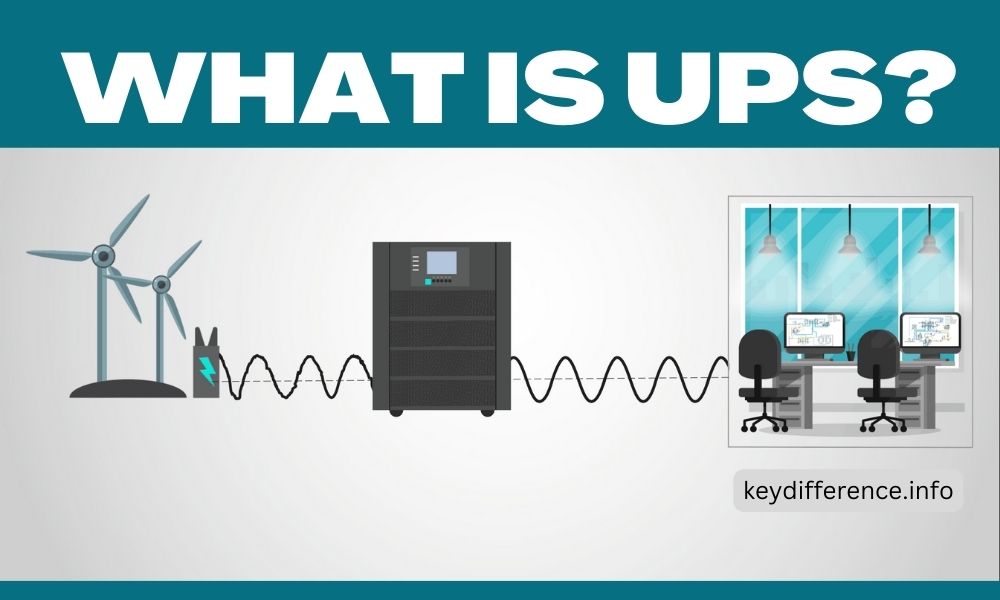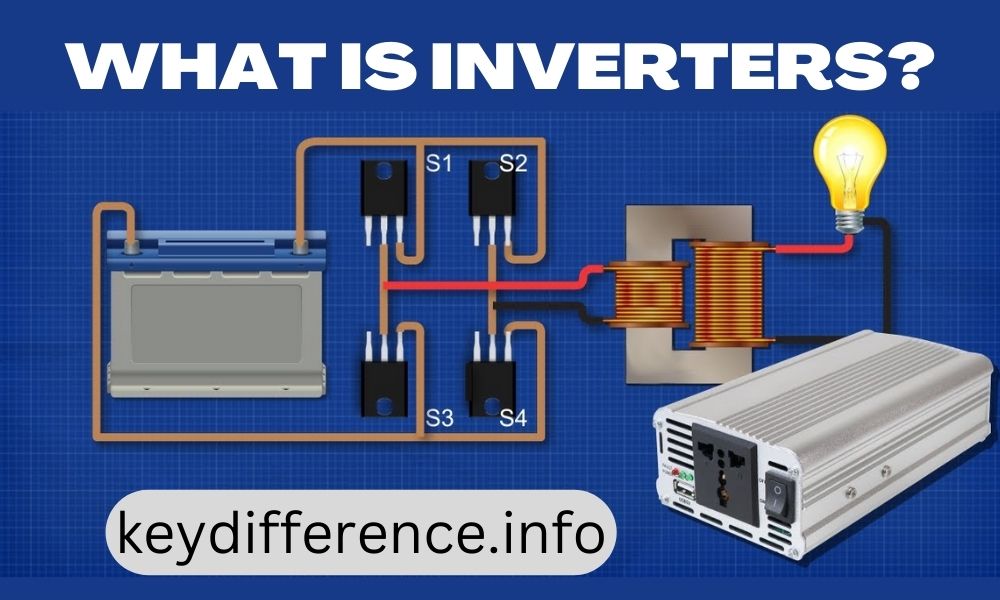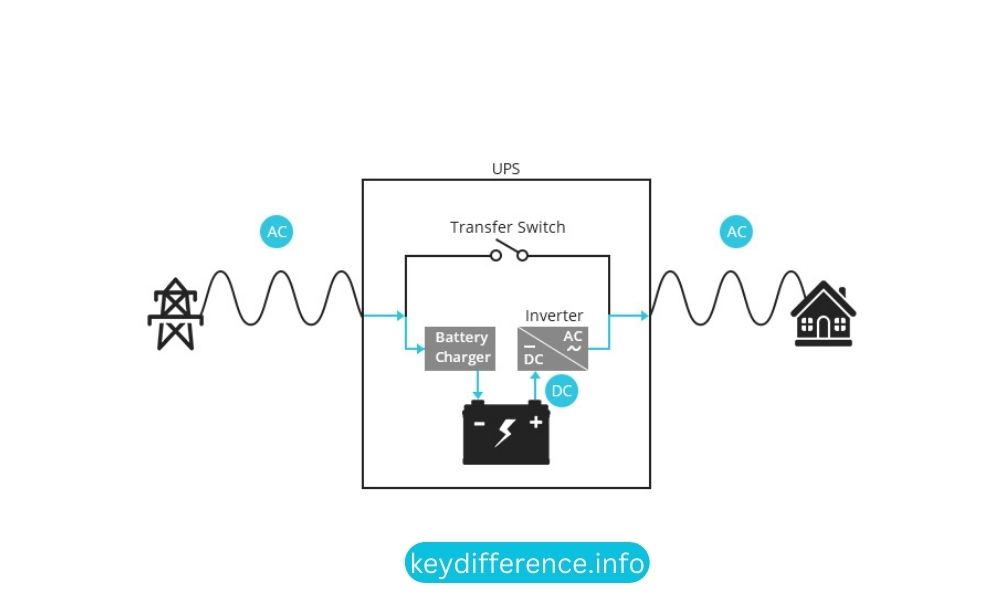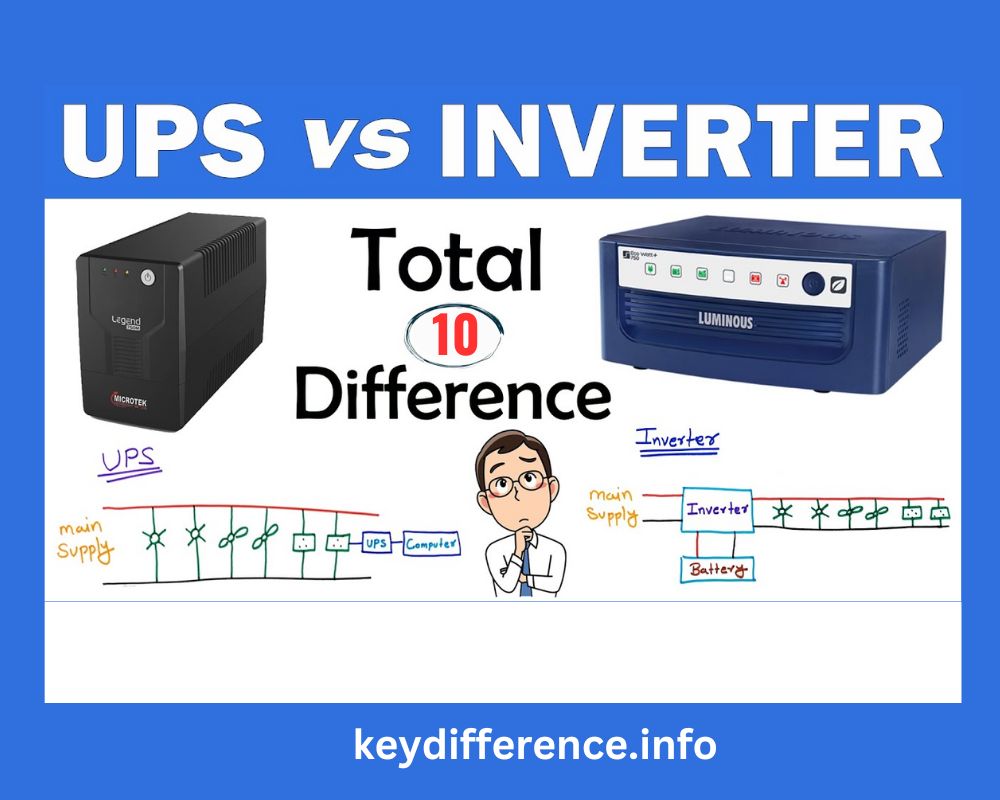UPS and Inverters provide backup power sources during major power outages. In our everyday lives, we’re heavily dependent on appliances that operate on electricity, such as lights, fans, and fridges.
They also have AC and more. When power is cut, power supply to appliances is cut off and they cease to function. But, if you’ve got an emergency power source by means of devices like UPS, generators, inverters or inverters which will allow for continuous electricity to your appliances so that they will not be affected by power outages.
Many people are still confused about the distinction between an Inverter and a UPS. This article will explain the distinctions between the two types of devices to help you gain a better understanding of their capabilities.
Although both devices supply backup power for mains interruptions There is only one difference the time delay. A UPS will immediately start the supply, in an inverter, there is the possibility of a delay of about one second, that is not acceptable for one is being worked on. In the case of other appliances, This delay is not a problem and is why UPS is used exclusively for computers, whereas inverters can be employed for other appliances in the home.
UPS (Uninterruptible Power Supply)

A UPS (Uninterruptible Power Supply) is a power backup device that ensures continuous power supply to connected equipment during electrical outages or fluctuations. It serves as a protective measure against power disruptions and provides a reliable source of power to critical devices.
Here are some key points about UPS:
Purpose and Function
- The primary purpose of a UPS is to provide uninterrupted power to connected devices, protecting them from data loss, equipment damage, or downtime.
- UPS systems act as a buffer between the main power source (utility power or generator) and the connected equipment, ensuring a smooth and seamless power transition.
How UPS Works
- UPS systems consist of several components, including a battery, an inverter, and a rectifier.
- The rectifier converts incoming AC power from the main source into DC power, simultaneously charging the battery.
- In the event of a power outage or fluctuation, the battery supplies power to the inverter.
- The inverter then converts the DC power from the battery back into AC power, which is used to supply electricity to the connected devices.
Types of UPS Systems
- Offline/Standby UPS: This type of UPS provides basic power backup and surge protection. It switches to battery power when it detects a power interruption or abnormal voltage levels.
- Line-interactive UPS: Line-interactive UPS systems offer enhanced protection against power fluctuations, voltage regulation, and battery backup. They are commonly used in small businesses and critical applications.
- Online/Double Conversion UPS: Online UPS systems provide the highest level of protection and power quality. They continuously convert AC power to DC power and then back to AC power, isolating connected equipment from power irregularities. Online UPS systems are often used in data centers, critical infrastructure, and medical facilities.
Features and Benefits of UPS
- Power Backup: UPS systems ensure uninterrupted operation during power outages, allowing critical devices to continue functioning.
- Voltage Regulation: UPS devices stabilize voltage fluctuations, protecting sensitive equipment from damage caused by overvoltage or undervoltage conditions.
- Surge Protection: UPS systems shield connected devices from voltage spikes and surges, safeguarding them against potential harm.
- Seamless Switchover: UPS systems provide a seamless transition from the main power source to battery power, minimizing downtime and preventing data loss.
Common Applications of UPS
- Computers and IT Equipment: UPS systems are commonly used to protect computers, servers, networking equipment, and data storage systems from power disruptions.
- Data Centers and Server Rooms: Data centers rely on UPS systems to maintain continuous power supply to critical servers and infrastructure.
- Medical Equipment: UPS devices play a crucial role in protecting life support systems, medical imaging equipment, and other healthcare devices from power interruptions.
- Telecommunication Systems: UPS systems ensure the uninterrupted operation of telecommunication infrastructure, including routers, switches, and communication servers.
A UPS is a power backup solution that provides a continuous and reliable power supply to connected devices during power outages, fluctuations, or other electrical disturbances. It offers features like power backup, voltage regulation, surge protection, and seamless switchover, making it an essential component in various applications where uninterrupted power is critical.
Inverters

Inverters are electronic devices that convert DC (direct current) power into AC (alternating current) power. Unlike UPS systems that primarily focus on power backup, inverters are designed to enable the use of DC power sources, such as batteries or solar panels, to power AC equipment.
Here’s an overview of inverters:
Purpose and Function
- The primary purpose of an inverter is to convert DC power to AC power, allowing DC-based power sources to be used for running AC appliances, tools, or any equipment that operates on AC power.
- Inverters are commonly used in off-grid or standalone power systems, renewable energy systems (such as solar power systems), and applications where a portable power source is required.
How Inverters Work
- Inverters utilize electronic components, such as transistors and capacitors, to convert the input DC power into AC power.
- The DC power source, such as a battery bank or solar panels, provides the input power to the inverter.
- The inverter converts the DC power into AC power, which can be used to operate AC devices or appliances.
Types of Inverters
- Stand-alone Inverters: Stand-alone inverters are independent systems that convert DC power from batteries or other DC sources into AC power. They are commonly used in off-grid applications, remote locations, RVs, or boats where access to the main power grid is limited.
- Grid-tie Inverters: Grid-tie inverters convert DC power generated from renewable energy sources like solar panels into AC power that can be fed back into the main power grid. They enable the integration of renewable energy systems with the existing power grid, allowing excess power to be sold back to the utility company.
- Battery-based Inverters: Battery-based inverters, also known as inverter chargers, are used in systems where both power backup and inverter functionality are required. They convert DC power from batteries into AC power for immediate use and also charge the batteries when connected to an AC power source.
Features and Benefits of Inverters
- DC to AC Power Conversion: Inverters allow the conversion of DC power from batteries or other DC sources into AC power for running AC devices.
- Power Backup (Battery-based Inverters): Battery-based inverters provide power backup during outages by utilizing stored energy in batteries.
- Renewable Energy Integration (Grid-tie Inverters): Grid-tie inverters enable the efficient integration of renewable energy systems, such as solar panels, with the main power grid.
- Energy Efficiency and Cost Savings: Inverters enable the use of DC power sources, which can be more energy-efficient and cost-effective in certain applications.
Common Applications of Inverters
- Solar Power Systems: Inverters are an essential component of solar power systems as they convert the DC power generated by solar panels into usable AC power for homes, businesses, or the power grid.
- RVs and Boats: Inverters are used in recreational vehicles (RVs) and boats to convert DC power from batteries into AC power for operating appliances, lighting, and other equipment.
- Emergency Backup Power: Battery-based inverters provide backup power during emergencies or power outages, ensuring continuous operation of critical equipment or appliances.
Inverters are devices that convert DC power into AC power, allowing the use of DC-based power sources for operating AC equipment. They find applications in off-grid systems, renewable energy systems, and situations where power backup or portable power solutions are needed.
Whether it’s powering appliances with batteries or integrating solar power into the grid, inverters play a crucial role in enabling efficient and flexible power conversion.
Comparison chart between UPS and Inverters
Here’s a comparison chart highlighting the key differences between UPS (Uninterruptible Power Supply) and inverters:
| Feature | UPS (Uninterruptible Power Supply) | Inverter |
|---|---|---|
| Power Backup | Provides instant backup power during outages | Converts DC power to AC power for off-grid applications |
| Switchover Time | Near-instantaneous switchover | Slightly longer switchover time |
| Seamless Operation | Offers seamless transition without interruptions | May cause temporary interruptions during switchover |
| Voltage Regulation | Often includes voltage regulation capabilities | Typically does not offer voltage regulation |
| Surge Protection | Provides protection against power surges and spikes | Generally does not offer surge protection |
| Load Capacity | Available in various capacities for different needs | Capacity can be selected based on specific requirements |
| Efficiency | Generally lower efficiency due to energy conversion | Higher efficiency as it primarily converts DC to AC |
| Advanced Features | Can include power conditioning, automatic shutdown | Limited advanced features compared to UPS |
| Cost | Tends to be more expensive | Can be a more cost-effective option |
| Application Suitability | Ideal for critical equipment, data centers, servers | Suitable for off-grid systems, remote locations |
Similarities: UPS and Inverters
While UPS (Uninterruptible Power Supply) systems and inverters have some fundamental differences, there are also several similarities between the two.
Here are some commonalities:
Power Backup
- Both UPS systems and inverters provide a form of backup power during outages or disruptions in the main power supply. They help maintain the operation of connected devices, appliances, or equipment by supplying electrical power.
AC Power Conversion
- Both UPS systems and inverters convert DC (direct current) power into AC (alternating current) power. UPS units receive AC power from the mains and convert it to DC power for battery charging. Inverters, on the other hand, take DC power from sources such as batteries or solar panels and convert it into AC power for operating AC appliances.
Load Support
- Both UPS systems and inverters are designed to handle various loads, including sensitive equipment or appliances. They provide power to critical devices, ensuring uninterrupted operation and protecting against potential damage or data loss.
Power Conditioning
- Some UPS systems and inverters offer power conditioning features to regulate and stabilize the voltage, frequency, or waveform of the power being supplied. This helps protect connected devices from voltage fluctuations, surges, or harmonics.
Backup Time Options
- Both UPS systems and inverters come in different models and capacities, allowing users to choose the backup time they require. They offer options with varying battery sizes or capacities to meet different power backup needs.
Protection against Power Surges
- Many UPS systems and some inverters include surge protection capabilities to safeguard connected devices from power surges, spikes, or transient voltage events.
Application Flexibility
- Both UPS systems and inverters find applications in a wide range of settings, including residential, commercial, and industrial environments. They are used in homes, offices, data centers, healthcare facilities, and other settings where uninterrupted power supply or backup power is crucial.
Advantages of UPS and Inverters
There are several Advantages UPS (Uninterruptible Power Supply) and inverters.
Here are the main Advantages:
Advantages of UPS (Uninterruptible Power Supply)
- Power Protection: UPS systems provide reliable backup power during outages, ensuring uninterrupted operation of critical equipment and preventing data loss or damage.
- Seamless Power Transition: UPS units offer seamless switchover from mains power to battery power, avoiding disruptions or downtime in sensitive applications.
- Voltage Regulation: Many UPS systems include voltage regulation capabilities, stabilizing the incoming power and protecting devices from voltage fluctuations or spikes.
- Surge Protection: UPS units often feature built-in surge protection, safeguarding connected equipment against power surges and transient voltage events.
- Advanced Features: UPS systems may offer additional features such as power conditioning, automatic shutdown software, and remote monitoring, providing enhanced control and protection for connected devices.
Advantages of Inverters
- Off-Grid Capability: Inverters allow for off-grid power systems, enabling you to operate electrical devices or appliances in remote areas without access to the main power grid.
- Utilization of DC Power Sources: Inverters convert DC power from batteries, solar panels, or other DC sources into AC power, making them suitable for renewable energy systems and utilizing stored energy.
- Cost-Effectiveness: Inverters can be a cost-effective solution, especially when compared to UPS systems, particularly for applications that primarily require converting DC power to AC power.
- Higher Efficiency: Inverters typically have higher efficiency levels as they focus on converting DC power to AC power, minimizing energy loss in the conversion process.
- Flexibility and Portability: Inverters are often lightweight and portable, making them suitable for mobile applications, outdoor activities, or emergency power needs.
It’s important to consider these advantages in the context of your specific needs, such as the requirement for uninterrupted power, load capacity, power source availability, and the desired features or functionalities. This will help you determine which option, UPS or inverter, aligns best with your requirements and priorities.
Disadvantages of UPS and Inverters
Disadvantages of UPS (Uninterruptible Power Supply)
- Cost: UPS systems can be more expensive compared to inverters, particularly for units with higher backup capacity and advanced features. The initial investment cost and ongoing maintenance expenses may be higher.
- Limited Backup Time: The backup time provided by UPS systems is typically limited by the capacity of their internal batteries. Depending on the load and battery size, UPS units may only offer a few minutes to a few hours of backup power, which may not be sufficient for prolonged outages.
- Battery Maintenance: UPS systems rely on batteries for backup power, and these batteries require periodic maintenance, such as replacement or recharging. This adds to the overall cost and maintenance requirements of the UPS system.
- Size and Weight: UPS units, especially those with higher backup capacities, can be bulky and heavy, requiring adequate space for installation. This may be a limitation in certain environments with space constraints.
Disadvantages of Inverters
- Switchover Time: Inverters may have a slightly longer switchover time compared to UPS systems during power outages. This can result in temporary interruptions or device restarts, which may not be suitable for applications sensitive to power disruptions.
- Lack of Advanced Features: Inverters typically do not offer the same level of advanced features as UPS systems, such as voltage regulation, surge protection, or monitoring capabilities. This may limit their ability to provide enhanced power quality and protection for connected devices.
- Compatibility with Sensitive Equipment: Some sensitive electronic equipment may require the stable and regulated power provided by UPS systems. Inverters may not offer the same level of power conditioning or protection, potentially affecting the performance or longevity of such equipment.
- Power Source Dependency: Inverters rely on an external power source, such as batteries or renewable energy systems, to convert DC power to AC power. This means they are dependent on the availability and capacity of the power source, which may need additional maintenance or monitoring.
It’s important to consider these disadvantages while evaluating the suitability of UPS and inverters for your specific needs. Assess how these limitations may impact your power requirements, application sensitivity, budget, and available resources to make an informed decision.
Choosing between UPS and Inverters
Choosing between a UPS (Uninterruptible Power Supply) and an inverter depends on your specific power backup or power conversion needs.
Here are some factors to consider when making a decision:
Power Backup Requirements
- If your primary concern is an uninterrupted power supply during outages or voltage fluctuations, a UPS is typically the preferred choice. UPS systems are designed specifically to provide instant backup power and protect critical equipment from power disruptions.
Power Source and Off-Grid Capabilities
- If you require a power solution that can utilize DC power sources, such as batteries or solar panels, to power AC appliances or devices, an inverter is a suitable option. Inverters allow for off-grid or standalone power systems, making them ideal for remote locations or situations where access to the main power grid is limited.
Switchover Time and Seamless Operation
- If your applications require a near-instantaneous switchover from mains power to battery power during outages, a UPS is the recommended choice. UPS systems offer a seamless transition, ensuring continuous operation without any interruption or data loss.
Efficiency and Energy Conversion
- If energy efficiency is a key consideration, inverters tend to have higher efficiency levels. Inverters primarily focus on converting DC power to AC power, resulting in more direct energy conversion. It’s important to note that modern UPS systems have also improved their efficiency levels over time.
Application-Specific Considerations
- Consider the specific needs of your application. If you are setting up a data center, server room, or medical facility where uninterrupted power is critical for sensitive equipment, a UPS system with its advanced features, such as voltage regulation and surge protection, may be the most appropriate choice.
- For off-grid applications, remote locations, or situations where utilizing renewable energy sources like solar panels is a priority, an inverter provides the necessary DC to AC power conversion capabilities.
Budget and Cost Considerations
- Compare the costs associated with UPS systems and inverters. UPS systems tend to be more expensive due to their advanced features and capabilities, while inverters can offer a more cost-effective solution for certain applications.
The choice between a UPS and an inverter depends on your specific requirements, including the need for power backup, power source compatibility, switchover time, efficiency considerations, and application-specific needs. Evaluating these factors will help you make an informed decision and select the appropriate solution that best suits your needs.
Which one should I select for my business/home Inverter or UPS?
The choice between a UPS (Uninterruptible Power Supply) and an inverter for your home or business depends on your specific requirements and priorities. Here are some factors to consider:
Power Backup Needs
- If your home or business requires an uninterrupted power supply during outages or voltage fluctuations, a UPS is typically the recommended choice. UPS systems provide instant backup power and protect critical equipment from power disruptions. They are designed to ensure continuous operation and prevent data loss or equipment damage.
Power Source and Off-Grid Capabilities
- If you have DC power sources available, such as batteries or solar panels, and you want to convert that DC power to AC power to operate AC appliances or devices, an inverter is the suitable option. Inverters enable off-grid or standalone power systems and are ideal for remote locations or situations where access to the main power grid is limited.
Load Capacity
- Consider the power requirements of your home or business. UPS systems are available in various capacities, ranging from small units for individual computers to larger units capable of powering an entire office or building. Inverters can also be selected based on their capacity to handle the specific power demands of your appliances or equipment.
Switchover Time and Seamless Operation
- If your applications require a near-instantaneous switchover from mains power to backup power, a UPS is the recommended choice. UPS systems offer a seamless transition, ensuring uninterrupted operation without interruption or data loss. Inverters may have a slightly longer switchover time.
Efficiency and Energy Consumption
- Consider the energy efficiency of the system. UPS systems may have lower overall efficiency due to the energy conversion process involved. In contrast, inverters tend to have higher efficiency since they primarily focus on converting DC power to AC power.
Budget and Cost Considerations
- Compare the costs associated with UPS systems and inverters. UPS systems tend to be more expensive due to their advanced features, battery backup, and high-quality power output. Inverters can offer a more cost-effective solution, especially if you already have DC power sources available.
Evaluate your specific power requirements, the need for backup power, power source compatibility, switchover time, efficiency considerations, and budget constraints. It can be helpful to consult with a professional or an expert in power backup and conversion systems who can assess your specific needs and recommend the most suitable solution for your home or business.
When I’ve got an inverter installed in my home is it necessary to get an UPS?

If you already have an inverter in your house, whether or not you need a UPS (Uninterruptible Power Supply) depends on your specific requirements and priorities. Consider the following factors to make an informed decision:
Power Backup
Assess your need for an uninterrupted power supply during outages or voltage fluctuations. If your existing inverter provides sufficient backup power to meet your needs and ensures uninterrupted operation of critical appliances or equipment, you may not necessarily need a UPS.
If you require additional backup capacity or advanced features such as seamless switchover and surge protection, a UPS could be beneficial.
Load Capacity
- Evaluate the capacity of your existing inverter and compare it to the power requirements of your appliances or equipment. Ensure that your inverter has sufficient capacity to handle the load without overloading the system. If your current inverter meets your power needs adequately, a UPS might not be necessary.
Switchover Time and Seamless Operation
- Consider the switchover time of your inverter during power outages. If your existing inverter provides a seamless transition from mains power to battery power without interruption or data loss, a UPS may not be essential. If the switchover time is longer or causes interruptions, a UPS could provide a smoother power transfer during outages.
Advanced Features
- Evaluate if your inverter offers features such as voltage regulation, surge protection, or compatibility with sensitive equipment. If these features are critical for the protection and proper functioning of your appliances or devices, a UPS with these capabilities could provide additional benefits.
Budget and Cost Considerations
- Assess the cost implications of adding a UPS to your existing setup. Consider the investment required for a UPS system, including its capacity, features, and maintenance costs. Compare this with the potential benefits and enhanced power backup capabilities it would provide.
Ultimately, the decision to add a UPS to your existing inverter setup depends on the specific requirements of your home, the capacity and capabilities of your inverter, and your budget.
Assessing your need for uninterrupted power supply, load capacity, switchover time, advanced features, and cost considerations will help you determine whether a UPS is necessary to complement your existing inverter or if your current setup meets your power backup needs adequately.
Conclusion
UPS ensures uninterrupted power and comes with an integrated battery that provides an instant backup of critical devices in the event of an outage, and with short transfer times. Inverters transform DC power generated by solar panels or batteries into AC energy for appliances in the home they need additional batteries to backup them and also have a bit longer time to transfer. UPS is a great option for crucial electronic equipment, while inverters are suitable for appliances that are off grid and for household usage during power outages.

